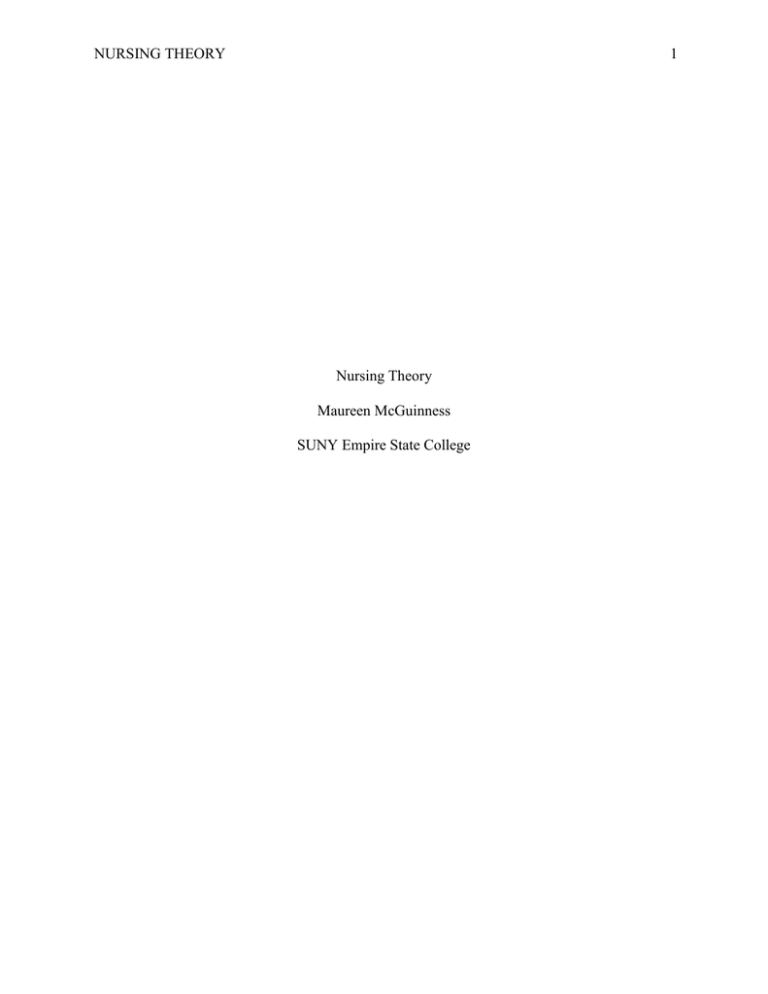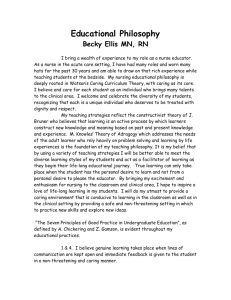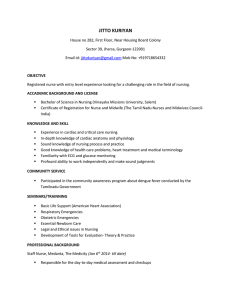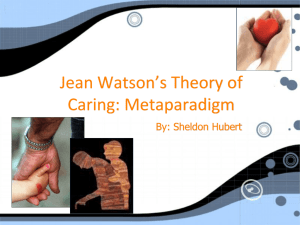Nursing Theory - maureen a mcguinness, RN
advertisement

NURSING THEORY 1 Nursing Theory Maureen McGuinness SUNY Empire State College NURSING THEORY 2 Nursing is a work in progress. It is a profession that is constantly in a state of evolution. It is a dance between art and science, a marriage of the subjective experience and the objective exertion of the machine we call the human anatomy. It is human by nature and divine in its intimacies. Nursing is governed by the laws of natures and physics, which must bend and mold to the individual being cared for. Each human being craves for a balance of wholeness and wellness and each nurse either fails or succeeds in aiding that individual towards their desired goals. Nursing is a compilation of theories, ever striving for perfection and synergy within itself. Watson’s Human Caring Theory expresses this vital dynamic of wholeness as a circuitry between patient and nurse. Watson describes nursing as a discipline that cuddles art and science, humanity and spirituality through the essentials of the mind-body-spirit connection. “The major conceptual elements of the theory are carative factors, transpersonal caring relationships, and caring moment/caring occasion.” For Watson human caring is not just an emotion but a response, a moment of action, a choice to go beyond what is comfortable for the nurse. Watson believes caring is a response which is both intersubjective and interpersonal. Caring is more than a cure it is health, aiding the patient to realize their potential and supporting them in their journey towards fulfillment (Hayes, 2011). When caring for a patient it is important for the nurse to draw upon all their knowledge, experience and intuition. According to Jean Watson on her 6th Caritas Process, we need to look from the patient’s frame of reference and honor their subjectivity and inner wisdom (Watson, 2013). When we are able to do this as nurses we help the patient to integrate what they know, with what they now must process and learn. In the world of psychiatric nursing this can sometimes mean helping the patient to develop new views of their world and realistic NURSING THEORY 3 expectations for a healthier future. The nurse must detach herself from all judgement and assess the patient on all levels, what they believe about themselves, what they see in the world around them and how they perceive help will come. Caring in action is something that these patients recognize immediately, they may not trust it at first but with consistency and commitment the will come to trust and rely on their nurse as a confidant and healer. Mental illness is a complicated illness to treat, antibiotics or IV fluids will not fix the problem. There are no quick fixes, no cures and sometimes no relief. Watching a patient struggle with their illness is often hard. A woman with schizoaffective disorder has struggled with her illness for most her life. Day in and day out she struggled against the voices in her head that told she was no good and that she should die. “I know these voices aren’t real but I can’t stop them, they won’t leave me alone!” There was no medication to date that has helped, ECT has failed and her psychiatrist is at a loss. We all were. What could we do to help this woman? Letting her know that someone cared about her and understood how difficult her daily struggle gave her some solace. Not everyone could or would offer this little piece of caring. For some the day in and day out aggressive behavior, head banging and STAT IM’s wore down their compassion. What was this patient’s frame of reference? What was her subjective experience? Hopelessness, frustration, anger, and fear all plagued this woman. As a nurse it is important to understand and respect these feelings, to be patient and caring. It is through the use of these tools that the most intimate connection can be made between nurse and patient. For just a few moments this patient can feel the relief that comes with knowing that someone truly cares for them. Although Watson has a comprehensive model with her 10 Caritas Process many other theories can and are used in patient care. Another patient benefited from a combination of Watson’s Human Caring Theory and Henderson’s Theory. Henderson theory has four major NURSING THEORY 4 concepts. The first is in regards to the individual and their basic needs as a component of health. The theory presents that the patient as the sum of their parts, an integrated person. Similar to Watson the mind and spirit are interrelated. The first concept offers “assistance to achieve health and independence or a peaceful death (Unknown, 2012).” This first concept of Henderson describes the very real physical assistance that a patient dieing from cancer needs. Unlike Watson she does not fully explore the mind-body-spirit connection but she does emphasize the need for physical care and attending to the environment of the patient. For this last patient discussed attending to her physical needs were of primary importance. Her dependance on nursing and nursing staff was equal to her terminal diagnosis. Essential treatment included adequate pain control, consistent turning and positioning, adequate hydration and vigilant skin care. Similar with Maslow’s Hierarchy, Henderson placed physiological needs at the top of the pyramid, followed by safety, belongingness and love, and esteem needs (Unknown, 2012). These are all of primary importance yet combined with Watson’s theory the treatment for this terminal patient was whole and complete. While caring for her physical needs the nurse presented herself to be there for her emotional needs. When the bed bath was finished or the pain medication the nurse would sit with her quietly and hold her hand. She would listen when she cried that no one came to see her and in the end she died at peace with herself, and the world around her. Just as medicine builds upon the efforts of past mathematicians and scientists by defining and redefining the realities of today’s world, so does nursing. Henderson’s Theory can be seen as limited, failing to define the link between the physiological and human characteristics. Her emphasis on a human beings need for physiological care, safety, love and esteem is an essential part of the process of healing. Add to this recipe Watson Human Caring Theory and together we have a more complete integration of patient care and the greatest potential for the personal NURSING THEORY 5 growth of the nurse. No one theory can define what wholeness is for an individual person, but it can teach us and gives the tools to assess each patient on all levels of their existence and care for them in the best way possible. Nursing requires us to listen, to see, and to act and react in a knowledgeable way. Expand these principles to embrace the patient as a whole with their belief or non-belief in God, with their fears and inhibitions, courage and strength and then we will begin to recognize the miracles as they occur on all planes. NURSING THEORY 6 References Hayes, K. K. (2011). Professional Nursing Practice: Concepts and Perspectives (Sixth ed.). Saddle River, New Jersey, USA: Julie Levin Alexander. Unknown. (2012, February 4). Nursing Theories: a companion to nursing theories and models . Retrieved March 16, 2013, from Education Connection: http://currentnursing.com/nursing_theory/Henderson.html Watson, J. (2013, March 11). ”6th Caritas Process – Problem-Solving, continued“. Retrieved March 14, 2013, from Watson Caring: http://watsoncaringscience.org/about-us/caring-science-definitionsprocesses-theory/articles-for-download/






